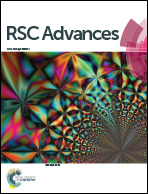Highly selective and sensitive colorimetric and fluorescent chemosensor of Fe3+ and Cu2+ based on 2,3,3-trimethylnaphto[1,2-d] squaraine
Abstract
A squarylium dye, 2,3,3-trimethylnaphto[1,2-d]pyrrole squaraine (TPSQ) based dual signaling probe was found to exhibit colorimetric and fluorescent properties on selective binding towards Fe3+ and Cu2+ in ethanol/water (4 : 1, v/v) solution, respectively. The binding constants were determined to be 6.22 × 104 M−1 and 4.08 × 104 M−1 for Fe3+ and Cu2+, respectively. Most importantly, the 1 : 1 stoichiometry of the host–guest complexation was confirmed by Job's method. Meanwhile, the selectivity experiments revealed that the colorimetric and fluorescent sensor were specific for Fe3+ and Cu2+ even with interference by high concentrations of other metal ions. Moreover, the sensing abilities of the receptor toward Fe3+ and Cu2+ were also investigated by electrochemical technique. The present results indicated that the TPSQ chemosensor could be adopted as a sensitive and reversible colorimetric and fluorescent sensor for Fe3+ and Cu2+.
![Graphical abstract: Highly selective and sensitive colorimetric and fluorescent chemosensor of Fe3+ and Cu2+ based on 2,3,3-trimethylnaphto[1,2-d] squaraine](/en/Image/Get?imageInfo.ImageType=GA&imageInfo.ImageIdentifier.ManuscriptID=C5RA22530B&imageInfo.ImageIdentifier.Year=2016)

 Please wait while we load your content...
Please wait while we load your content...